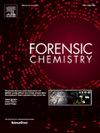Assessment of adsorption interference from carbonaceous materials in post-explosion residue analysis of fuel–oxidizer mixtures by ion chromatography
IF 2.6
3区 医学
Q2 CHEMISTRY, ANALYTICAL
引用次数: 0
Abstract
This study investigated the influence of carbonaceous materials on the extraction and analysis of post-explosion residues by ion chromatography (IC). Three adsorptive materials—activated carbon, carbonized paper residue, and vegetal charcoal—were evaluated for their capacity to retain inorganic ions typically found in combustion/explosion residues of flash powder, black powder, and explosive emulsions. The targeted ions included Cl−, NO₂−, OCN−, ClO₃−, NO₃−, SO₄2−, S₂O₃2−, SCN−, ClO₄−, K+, NH₄+, and Na+. The results showed significant ion-specific retention effects, particularly for oxidizing anions, which varied depending on the type and amount of adsorbent. Additional experiments comparing room temperature and heated (90 °C) aqueous extractions demonstrated that heating does not provide a consistent solution to the problem of ion adsorption. These findings underscore the risk of false negatives or underestimation of analytes caused by the presence of carbon-rich debris, commonly found in post-explosion samples. The study highlights the importance of considering adsorptive interference when selecting sample portions for analysis, prioritizing areas with minimal carbonaceous content. These findings contribute to improving the reliability of IC and other aqueous extraction-based methods used in the forensic analysis of explosive residues.
离子色谱法评价燃料-氧化剂混合物爆炸后残留物分析中碳质物质的吸附干扰
研究了含碳材料对离子色谱法提取和分析爆炸残留物的影响。对活性炭、炭化纸屑和植物炭这三种吸附材料的吸附能力进行了评估,以确定它们对闪光粉、黑火药和爆炸乳剂燃烧/爆炸残留物中常见的无机离子的吸附能力。目标离子包括Cl−,没有₂−,OCN−,ClO₃−,没有₃−,所以₄2−,S₂O₃2−,SCN−,ClO₄−,K +、NH₄+和Na +。结果显示了显著的离子特异性保留效果,特别是氧化阴离子,这取决于吸附剂的类型和量。另外的实验比较室温和加热(90°C)水萃取表明,加热不能提供离子吸附问题的一致解决方案。这些发现强调了由于爆炸后样品中常见的富含碳的碎片的存在而导致的假阴性或低估分析物的风险。该研究强调了在选择样品部分进行分析时考虑吸附干扰的重要性,优先考虑碳含量最低的区域。这些发现有助于提高IC和其他基于水萃取的方法在爆炸残留物法医分析中的可靠性。
本文章由计算机程序翻译,如有差异,请以英文原文为准。
求助全文
约1分钟内获得全文
求助全文
来源期刊

Forensic Chemistry
CHEMISTRY, ANALYTICAL-
CiteScore
5.70
自引率
14.80%
发文量
65
审稿时长
46 days
期刊介绍:
Forensic Chemistry publishes high quality manuscripts focusing on the theory, research and application of any chemical science to forensic analysis. The scope of the journal includes fundamental advancements that result in a better understanding of the evidentiary significance derived from the physical and chemical analysis of materials. The scope of Forensic Chemistry will also include the application and or development of any molecular and atomic spectrochemical technique, electrochemical techniques, sensors, surface characterization techniques, mass spectrometry, nuclear magnetic resonance, chemometrics and statistics, and separation sciences (e.g. chromatography) that provide insight into the forensic analysis of materials. Evidential topics of interest to the journal include, but are not limited to, fingerprint analysis, drug analysis, ignitable liquid residue analysis, explosives detection and analysis, the characterization and comparison of trace evidence (glass, fibers, paints and polymers, tapes, soils and other materials), ink and paper analysis, gunshot residue analysis, synthetic pathways for drugs, toxicology and the analysis and chemistry associated with the components of fingermarks. The journal is particularly interested in receiving manuscripts that report advances in the forensic interpretation of chemical evidence. Technology Readiness Level: When submitting an article to Forensic Chemistry, all authors will be asked to self-assign a Technology Readiness Level (TRL) to their article. The purpose of the TRL system is to help readers understand the level of maturity of an idea or method, to help track the evolution of readiness of a given technique or method, and to help filter published articles by the expected ease of implementation in an operation setting within a crime lab.
 求助内容:
求助内容: 应助结果提醒方式:
应助结果提醒方式:


